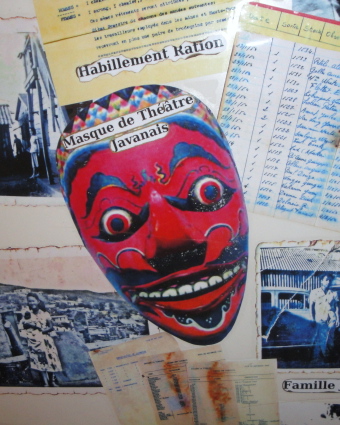Pam Allen
Javanese mask at Tiebaghi villagePam Allen |
Aged 65 and still working as an engineer in Noumea, the capital of New Caledonia, Djintar Tambunan is a member of an unusual minority. He is one of very few Indonesians in New Caledonia who speak fluent Indonesian. His Javanese wife Soetina does not. Nor do his two adult children. Like most of their Indonesian friends, their preferred language is French.
Born in Belige, on the shores of Lake Toba, North Sumatra, in 1945, Tambunan (as he prefers to be called) moved to the Pacific Island of New Caledonia during the mining boom in 1970. He came to work for the big construction company Citra, and has remained there ever since. He describes himself as part of the 'third wave' of Indonesian emigrants.
Who, then, comprised the first and second 'wave' of emigrants, and what were they doing in New Caledonia? Djintar Tambunan's story, and that of the 7000 or so other Indonesians currently living there, forms part of a relatively little-known chapter in the history of Indonesia. Like the history of the Javanese in Suriname in South America, and that of the Cape Malays in South Africa, it is an intriguing story of the tension that results when populations move, or are moved, to new surroundings.
Javanese immigration
That first wave of Javanese emigrants comprised 170 contract labourers, who arrived in Noumea in 1896. Forty-two years earlier, Napoleon III had established a penal colony in the French possession of New Caledonia. Most of the convicts transported there were political prisoners from the Paris Commune. In 1894, the French Governor of New Caledonia, Paul Feillet, abolished penal immigration and replaced prison labour with Asian immigrants, mainly from Japan, Java and Vietnam, who came to work in the mines and on the plantations.
Initially sent to work in agriculture, from 1899 the Javanese began working in the mining industry, which offered better pay but more difficult conditions. They were expected to work long hours with pick and shovel and to put up with demanding French employers. Once their contract term had ended, some returned to Java. But many remained in New Caledonia, a choice that robbed them of their right to repatriation. It was a choice that also brought with it the burden of paying the costs of finding new employment.
The second wave of immigration of Javanese occurred in the years preceding World War II when the New Caledonian economy faced a chronic labour shortage with a boom in nickel and coffee production. Between 1933 and 1939, over 7800 Javanese left Java for Noumea. Many of these had been signed on to five-year contracts by recruiting agencies. When they arrived they found employment in agriculture and mining, as well as in domestic labour.
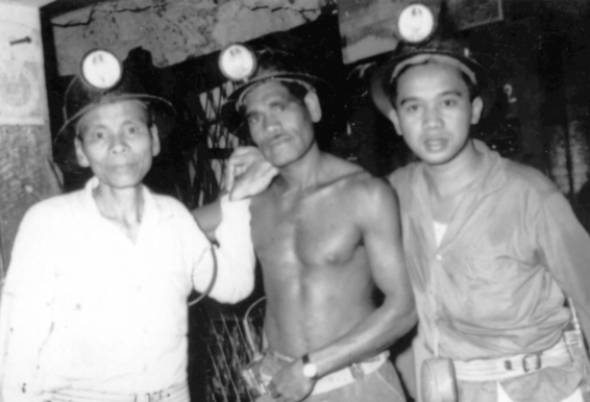 |
A multi-ethnic mining crew consisting of Vietnamese, Melanesian and JavaneseImage courtesy of the Association Pur La Sauvegarde du Patrimoine Minier et Historique du Nord Caledonien |
The most compelling contemporary relic of the first and second waves of Indonesians in New Caledonia is the abandoned Tiebaghi mining village in the remote mountainous region near Koumac in the north. This was the destination for many Indonesian contract labourers (both new immigrants and locally born) between 1896 and 1949. In Tiebaghi, the Javanese worked underground in the lucrative chrome mine, alongside Vietnamese and Japanese, all valued for their agility and small physical stature, which ostensibly made it 'easy' for them to negotiate the underground tunnels.
The mine site and the relics of the mining village are currently being restored by the Association for the Protection of North Caledonian Mining and Heritage. They harbour a wealth of information about life in the multicultural mining community which, as well as housing the Asian labourers, was home to Italian, American, French, Caledonian, Wallisian and Melanesian miners and their families.
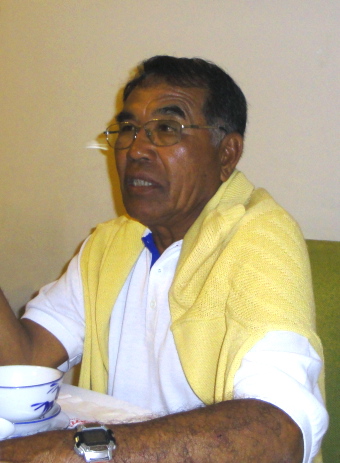 |
Djintar Tambunan is a third wave emigrant from IndonesiaPam Allen |
While language prevented some non-French speaking Javanese from mixing with the other ethnic groups, sport, music and theatre brought everyone together. The Javanese played soccer for the Tiebaghi team, the Chromes, and photographs abound of them playing a variety of musical instruments, including guitar and accordion, and performing classical Javanese theatre in the Tiebaghi Club. While most were Muslim, there was no mosque in Tiebaghi, so prayers were conducted at home.
Javanese niaouli
The New Caledonia-born descendants of the first and second wave Javanese emigrants, such as Tambunan's wife Soetina, are referred to as niaouli, after the niaouli tree, a hardy eucalypt that is emblematic of New Caledonia. There are differing views as to why this name was chosen to refer to the Javanese. The more prosaic view is that it simply refers to the fact that the Javanese were as resilient and adaptable as the niaouli. The more romantic view is that the name was given because the Javanese mothers working in the coffee plantations had the habit of hanging the sarong in which they cocooned their babies on the branches of niaoulis as they worked. Behind this, however, sits a somewhat less romantic context. Apparently Vietnamese women, being French citizens, were allowed maternity leave as afforded by French law. By contrast, Javanese women had no such entitlements and had to return to work, with their babies, immediately after giving birth.
The third wave of emigration, of which Djintar Tambunan was a part, comprised approximately 600 Indonesians who came to New Caledonia during the nickel boom between 1967 and 1972, to work on renewable annual contracts, mainly in the construction industry. The Javanese earned the reputation of being industrious workers. According to Tambunan, only a few of those third wave migrants remain in New Caledonia; the vast majority moved back to Indonesia and some have passed away. Those who remained in New Caledonia worked - and in some cases continue to work - in a variety of industries including engineering, transport and infrastructure development.
In addition to these three waves of migration, there were other 'categories' of migrants. Suminah (who calls herself Evelyne when she goes to France) is an example of a wong baleh – an Indonesian who was born in New Caledonia, was repatriated to Indonesia but later returned. Suminah moved to Indonesia with her mother in 1953 and then four years later returned to New Caledonia because her mother was unhappy with the move.
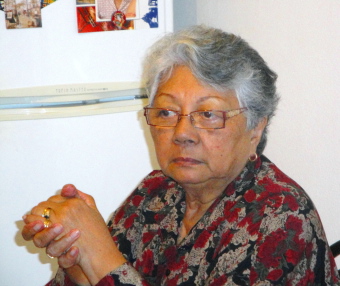 |
Suminah / Evelyne moves freely between Javanese andFrench culturesPam Allen |
Suminah is married to Andre Vaquijot, whose father came to New Caledonia from Java in 1902. Unlike his wife, Andre cannot speak Indonesian, although he understands it. Andre provides an interesting example of linguistic proficiency not being a prerequisite for cultural affiliation. Both he and Suminah are active members of the Indonesian Association of New Caledonia, in which Andre holds an executive position.
Shirly Timan is an example of a wong jukuan, or someone born in Indonesia but brought to New Caledonia by local Indonesians. Often these are women coming to get married. Shirly, who teaches Indonesian at the Indonesian Consulate in Noumea, came to Noumea twelve years ago to marry her niaouli husband. She spoke no French when she arrived and earned her living as a singer, an occupation in which she is still engaged. Now, however, she is sufficiently fluent in French to be able to use it to teach Indonesian.
Indonesia in New Caledonia
The tension between cultural hybridity and ethnic cohesion is evident among the Indonesians in New Caledonia. It is a tension that was faced by those early agricultural and mine labourers, who had to learn to speak French and eat bread rather than rice, but remained Muslim and loved to watch wayang performances. This tension is also felt by contemporary Indonesians who, while holding French passports, speak Javanese at home and are enthusiastic participants in events organised by the Indonesian Association of New Caledonia.
Analysis of demographic patterns in New Caledonia reveals that there is no distinctive 'Little Indonesia' in Noumea nor are there 'Indonesian' towns; Indonesians are dispersed throughout the country. The Consulate General of the Republic of Indonesia in Noumea (established in 1951) plays an important role in supporting and promoting Indonesian culture. The Consulate runs dance, gamelan and pencak silat (martial arts) classes, which attract both Indonesians and those from other ethnic groups. The twice-weekly Indonesian language classes are also well-attended. A significant number of the students are niaouli, many of whom travel regularly to Indonesia.
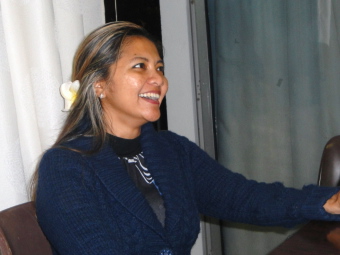 |
Shirly Timan is a recent immigrant who teaches Indonesian at theConsulatePam Allen |
While the majority of Indonesians in New Caledonia are Muslim, the mosque does not appear to have a strong role in the promotion and preservation of ethnic cohesion. The Islamic Centre of Noumea does organise religious celebrations and holidays, sometimes in cooperation with the Consulate of Indonesia, but the Islamic community in New Caledonia is multi-ethnic in nature, comprising Arabs, North Africans, Africans, Yugoslavs, Melanesians and French, as well as Indonesians, with the current Imam being from Saudi Arabia. Furthermore, current figures suggest that although there are about 3000 Muslims in New Caledonia, only a couple of hundred actively practise their faith.
However, there are a number of Indonesian associations in New Caledonia. Marcel Magi is one example of a niaouli who felt increasingly embarrassed that he could not communicate with his aunts, uncles and cousins there. Prompted by his sense of linguistic disconnectedness from the land of his ancestors, he wanted to forge some group and ethnic cohesion among locally born Indonesians. To this end, he was behind the establishment in 1999 of a group called Asal Usul, meaning Origins. The stated aim of Asal Usul is to safeguard the cultural identity of the Javanese in New Caledonia.
The various branches of the Indonesian Association of New Caledonia (whose President is Djintar Tambunan) also regularly organise events and celebrations designed to reinforce a sense of Indonesian identity, for example, a commemoration has been held to honour the arrival of the first Indonesians in New Caledonia, held annually since 1996. The official description of such events, in the press and on the Consulate website, is couched in rhetoric about the importance of the Indonesians feeling ‘equal’ to their 'Caledonian brothers' and being 'up to par' relative to other ethnic groups. There is also a strong sense of pride in the achievements of individual Indonesians in New Caledonia, such as the success of Member of Parliament Rusmaeni Sanmohamat, the sixth Vice President of New Caledonia. While diverse in interests, orientation and background, the Javanese of New Caledonia demonstrate a pride in their ethnic heritage and actively seek to nurture and maintain it.
Pam Allen (Pam.Allen@utas.edu.au) teaches Indonesian language and culture at the University of Tasmania in Hobart.
